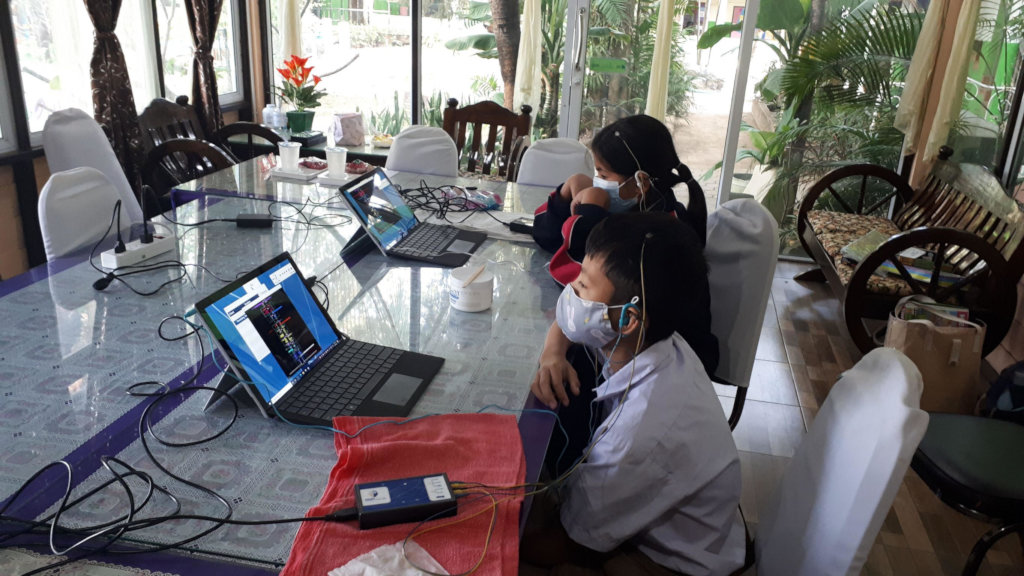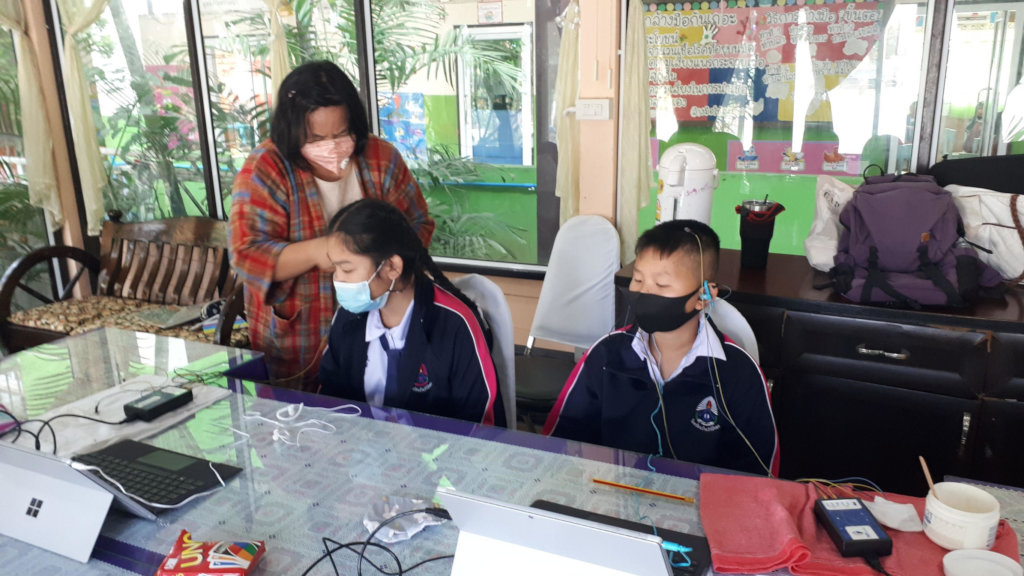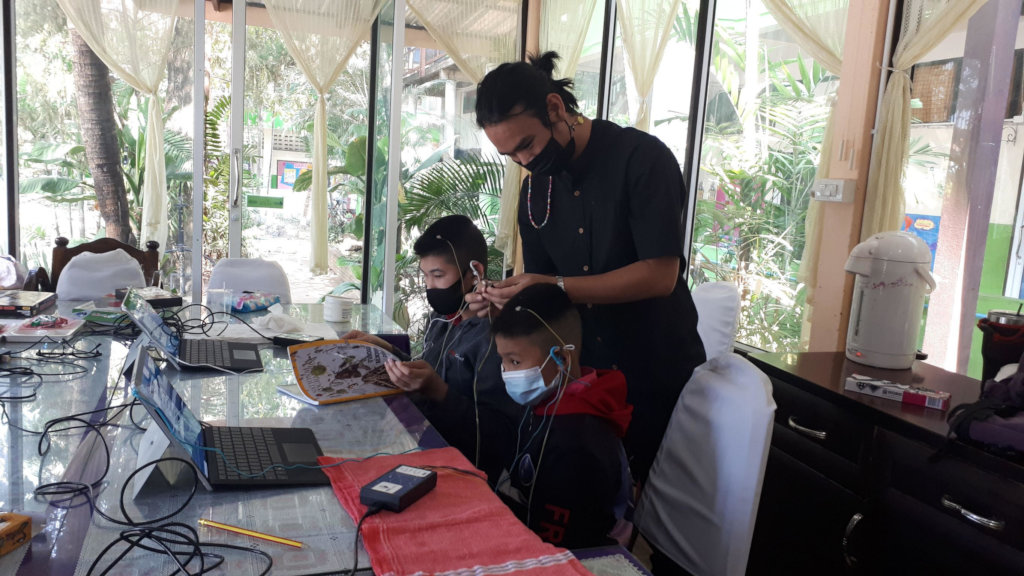![Neurofeedback training]()
Neurofeedback training
This is the first report to you from EACM, TRAIN 100 HILL TRIBE CHILDREN TO READ.
We have been giving NF training to 42 children since 25th August 2020. Due to the COVID-19 disruption to the school calendar this year, we cannot go back to give the post intervention assessment till the end of December. We will be sending you the scores of all children with reading fluency and reading comprehension scores.
We made home visit to 14 children. Please join us to get to know the stories of 3 children here.
Lahu tribe is known to preserve their native tradition and farming life styles remaining in the hills. They started moving in rural edges of Doi Saket. In the last few decades.
There are more than 100 families living here in the village. As we discovered, there are no walk way to get anywhere in the village. We had to navigate a path, making sure each footing is steady enough to avoid falling into heap of trash, debris from the construction and chicken coos.
BOY A
The first family we visited lived in a Lahu tribe settlement 3 km away from the rural school where we train NF with elementary children who have learning delay; more than 2 years behind their chronological level.
One of the 42 students we started on August 25th was “Boy A”, 10-year-old boy comes from this Lahu village.
The first one, Let’s call him “Boy A”. The teachers have problems with his ADHD traits. He does not like to sit in the class room wanders around the school and disappears in the afternoon.
He takes one-hour trek back to his house. He was reported to have aggressive behaviors against his class mates.
The first time he came to NF room. He did not want to corporate with the training, he pulled down the cables, and refused to get training. Slowly, he warmed up to us. After 20 sessions, the teacher reports no more leaving school early, he can sit still in the classroom most of the time. What’s more, he does not get into fights.
At home, he does not talk much, just hangs onto the mother, who has many other neighborhood children to sooth as well.
Mother is very happy he goes to school every day and hopes he will stay in school. The family came to the village 10 years ago, when “Boy A” was only 2.
The mother says life is getting much easier now they settled in this village. Mother’s dream is to move to a house facing a street, so that she can sell what she makes and get a bit of money aside.
BOY B
Just outside of Lahu village, that's the other Thai peoples’ neighborhood, there's this store that is a typical store in the country where they sell everything that people possibly need. The owner of the store they are immigrant from Myanmar.
Myanmar immigrants are very different from any other immigrants. They work hard because they came through the repression from the authoritarian military government and they barely survived to get to this country.
She said that nowadays she opened the store. She and husband woke up, left the house at 3:00 AM, went to market and bought produce and went to another market to sell her produce and then went back and opened the store at 8:00 o'clock. She said she's very happy that she had things, vehicles and she can buy the mobile for her children and she can pay for special tutoring services so they would really stay with the Thai children at public school.
This “Boy B” is 9 years old. He's not only delayed in reading but also has ADHD type of behaviors which he cannot sit still nor pay attention. He's always moving around and doing things. His mother is concerned about him as well as the oldest boy because they spent too much time playing games on mobile but she doesn't know how to control that.
Girl C
Then we visited a Thai family. This is a very fortunate situation. This “Girl C” is 11 and her parents abandoned her. She hardly remembers anything about the parents.
When that happens in typical Thai families, the children get passed around the different relatives. And usually, because they're poor, nobody really wants to take care of her yet another mouth to feed. But she was lucky enough the grandmother who is not really blood related, according to the grandmother, she has some money and owns a house so she can keep the child. And other adults who she calls mothers, but they seem to be aunts who look after her.
She does school work very well but she doesn't read well. She's more than two years behind. She is behavior wise and socially she is very well behaved, but she cannot read. So, whatever she wants to do it's going to get in her way. She says she wants to become home care nurse, and she likes to look after people who are in trouble.
We have given 20 session of neurofeedback to help her reading and she seems to be doing well but we don't know the result for sure until we give the post intervention assessment which we cannot do until December because the school schedule really was disrupted throughout the year due to COVID-19 so we cannot go in there until December so we have to wait until December for you to hear the result and compare before and after assessment.
![Home visit to Lahu tribe village - 01]()
Home visit to Lahu tribe village - 01
![Home visit to Lahu tribe village - 02]()
Home visit to Lahu tribe village - 02
![Home visit to Lahu tribe village - 03]()
Home visit to Lahu tribe village - 03
![Boy A - 01 - home visit]()
Boy A - 01 - home visit
![Boy A - 02 - Portrait]()
Boy A - 02 - Portrait
![Boy A - 03 - home visit]()
Boy A - 03 - home visit
![Boy B - 01 - Home visit]()
Boy B - 01 - Home visit
![Boy B - 02 - Home visit]()
Boy B - 02 - Home visit
![Boy B - 03 - Portrait]()
Boy B - 03 - Portrait
![Girl C - 01 - Home visit]()
Girl C - 01 - Home visit
![Girl C - 02 - Portrait]()
Girl C - 02 - Portrait
![Girl C - 03 - Neurofeedback training]()
Girl C - 03 - Neurofeedback training
Attachments:
![Share on Twitter]()
![Share on Facebook]()




